The Royal Doulton company first began in London during 1815 and has since become a global brand that produces some of the most well known and loved porcelain, dinnerware and collectable pieces. Throughout the ages there have been a variety of different stamps used to mark authentic Royal Doulton ornaments and tableware. In saying this, almost all Royal Doulton items will have either a back stamp or marking that can be found on the bottom of the item beneath the final glaze.
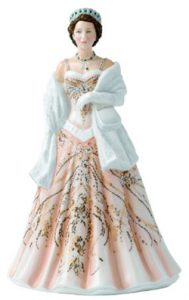
Contents
Change and Growth of the Company
John Doulton, a qualified manufacturers joined with John Watts, a foreman and Martha Jones, the Lambeth Pottery owner in 1815. They began producing pottery in a small factory in England trading under the name ‘Jones, Watts and Doulton‘. Their speciality at this time was salt glazed stoneware.
During 1820, Martha broke away from the company although it wasn’t until 1826 the two remaining owners changed the company name to ‘Doulton & Watts‘. The company had increased in popularity and to meet this demand the two men moved the company to a larger factory.
Eventually, John Watts retired from the company in 1854 which was then trading as ‘Doulton & Company‘. In 1873 when John Doulton passed away his son, Henry took complete control of the company.
By 1885, the Doulton company had risen drastically in popularity and was now becoming well known to the British Royal Family. In 1887, Queen Victoria knighted Henry Doulton for his contributions to the ceramic art and then later in 1901 King Edwards VII gave the company a Royal Warrant. From this Royal Warrant the company was then able to trade as ‘Royal Doulton‘, the name we are familiar with today.
The majority of the ornaments and dinnerware are now made in Indonesia. A small percent of higher-quality porcelain pieces are still made in the company’s home town, England. Due to the shift in quality of the Royal Doulton company, older pieces can often be worth a small fortune.
Royal Doulton Backstamp Through the Ages
The earliest Royal Doulton pieces sometimes have backstamps that read ‘Pinder Bourne & Co’ or have simple initials such as P.B or P.B & Co. Later backstamps from 1882 have definite logos and wording which can be found below.
1827 until 1882
During this period a number of simple stamps were impressed into Royal Doulton works of art. These impressed markings would read: ‘Doulton & Watts’, ‘Doulton & Watts Lambeth Pottery London’, ‘Doulton Lambeth’ and ‘Doulton Lambeth England’. Towards the end of this period the impressed words were bordered by an oval shape which slowly turned into the rounded shape in the backstamps to follow.
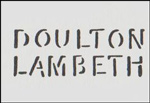
1882 until 1901
During this period, the simple Doulton Burslem England stamp with four interlocking ‘D’s was common on Royal Doulton pieces. The word ‘England’ that appears below this stamp was not added until 1891. A royal crown was added above the initial logo to mark the meeting between the company and the Prince of Wales. The logo with the royal crown was used especially on bone china and expensive earth wares. Both of these logos were used until 1901.
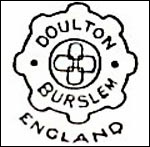
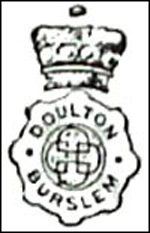
1901 until 1922
During this time periods, the recognisable Doulton logo was introduced. This logo consisted of the lion, crown and roundel. All three of these symbols are often associated with the company. This backstamp still included the four interlocking ‘D’s although the crown appeared less detailed than the one used in previous stamps.
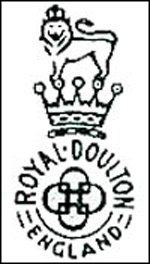
1922 until 1927
In this 5 year period, a backstamp was used that is similar to the previous stamp although is missing the crown. It is thought this stamp was introduced as it was smaller in height and could fit the wares that were being produced during that period. This mark was not widely used.
1928 until 1936
The marking that appeared on pieces until1922 was used again. This marking included the lion, crown and roundel. A year of production was also included in this new stamp. To find the year of production, you would need to add 1927 to the number that appears next to the backstamp.
1930 until 2000
From approximately 1930 the words ‘Made in England’ appear just below the crown. The date numbers were included until 1936. The words ‘Bone China’ are also part of the backstamp for those pieces created from Bone China. ‘Fine China’ was the wording used from 1973 and can be found on Royal Doulton ornaments that are produced today.
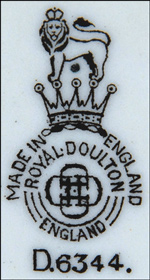
2000 until Present
The exact date when this new backstamp was introduced cannot be confirmed although it is believed it first appeared between 1993 and 2000. This new stamp can be found on tableware’s produced in the present time. This backstamp has the lion logo, although also has the words ‘Fine China Made in Indonesia’ or ‘Bangladesh’ along with a copyright date. This backstamp is a modernised version of the previous stamps used by the company.
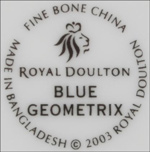
Special Royal Doulton Markings
Special marking and backstamps can be found on specific collections produced by the Royal Doulton Company.
Special Ware Markings
Special Royal Doulton series ware marks are present on a number of collections. These are designed specifically for that collection and the logo represents that directly. Some collections a speciality ware marking is apparent include ‘Under the Greenwood Tree’, ‘The Gallant Fishers’ and ‘Home Waters’.
Bunnykins
A range designed for young children features its own unique mark. All Bunnykins ware has a logo that features three bunnies and the words “Bunnykins”.
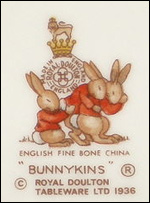
Morrisian Wares
A special marking for Morrisian Wares used between 1901 until 1924.
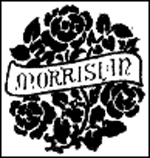
Titanium Wares
Titanium wares produced between 1916 until 1933 have their own special marking that reads ‘Royal Doulton Titanium England’.
Flambe Wares
The words ‘Royal Doulton Flambe’ appeared on early Flambe works of art.

Dating System for Royal Doulton
If you are lucky, your Royal Doulton piece may have an impressed date next to the trademark stamp. These impressed dates can come in the form of year, month and year and day, month and year. Sometimes these impressed dates are hard to see so insure you inspect your Royal Doulton item with a fine tooth-comb.
Code numbers were printed on the base of Royal Doulton produced between 1928 until 1954. These numbers appear next to the right of the crown. The rule of thumb with these numbers is to add 1927. For example, if your inked number is ‘1’ the year your item was manufactured in 1928. Until 1930 roman numerals were used to display this number and from 1930 until 1954 Arabic numerals were used.
Some Royal Doulton items have a latte number impressed in their base. These numbers were when the mould was created not the particular piece. Although not an exact date, a round about date can be worked out from this year considering most moulds would deteriorate quickly.
The copyright date of a Royal Doulton piece is not the best indication of age. A piece that has a copyright date of 1937 can be produced until 2004. The production of the figurine generally begins one year after the copy right date but that isn’t to say that is the year your piece was produced in.
Another marking that can be found on a Royal Doulton ornament is the artist’s mark. There have been hundred of artists that have worked for Royal Doulton over its lifespan. Each artist has a unique signature that usually represents their initials. For example, the artist Louisa Ayling uses a simple ‘a’ as her mark while Mary M Arding marks pieces created by her with ‘M.M.A’.
Summary of Royal Doulton Markings
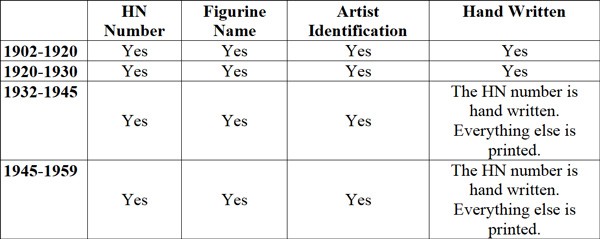
Hi there ! I bought a Royal Doulton Porcelain Figurine “Going Home”- two flying geese, but the figurine doesn’t have any mark on the bottom. Is that a sign that it is fake? I look online and it looks exactly the same that the ones with the marks. Can you help me with this?
Thanks!
No, it’s not a fake. It just happens to be a figure made by Royal Doulton that was missed in the labelling process. As a Royal Doulton Specialist Dealer for over 40 years I’ve had many pieces by Royal Doulton without a backstamp.
Hi,
I have two items with “Doulton Burslem” stamp (1882-1901) (a little jug-and-bowl set). Is it worth to have them valued and auctioned, or would you rather recommend eBay/other website to sell them?
Hello I’ve got a blue case with large yellow pears that stand out can you shed any light on this piece please
I have a set of 5 small cups with saucers and I have looked everywhere for the pattern and cannot find it they have a star printed under the royal doulton marking and a GR entwined on cup and saucer can anyone help?
The GR is probably the painter. I have those initials on the bottom of a Royal Doulton figurine.
Hi I have an Images Story of Christmas set and each one has a top hat on the base, why is that?
Hi I have a jardinere. It has the following initials MVM P 200 but no RD mark at all. I cant find anything like it anywhere on anything remotely RD. Any ideas?
I have the Pretty Ladies figurine Jasmine/long black dress with darker skin. The re is no oficial back stamp but the bottom is stamped “sample by casday” Does that mean anything significant?
It may be a piece of Doulton Lambeth stoneware. Mark V Marshall signed his pieces with his initials. He was a very well regarded artist. Lambeth ware sometimes has a model number etched in its base but usually does not. HN numbers were only used at their Burslem factory
What does a red X on the bottom of a Toby Mug indicate?
@Mark, I have looked into this and I have not found anything about a red x on toby jugs. I also looked at images from different time periods and found none with a x mark. a few had a red check mark but it looks like in most cases these were added to the figurine post production by a owner or shop keeper.
I have a “Paisley Shawl” lady that is marked:RN 753120 and hand marked HN1392 with artist initials BM. I know its old and original, it belonged to my Grandmother and I’ve looked at it all my life – I’m 74. Thank you for any help to identify the year, etc.
@ Sharon this figurine was issued between 1930 – 1949.
@Sharon, You are looking at $50 – $120 USD depending ont he condition of the figurine.
Hi, I have a Bunnykina porridge dish which has a hand painted 10 next to the crown. The trade mark is all black, including the lion. Towards the edge of the underside there is also a hand painted 21 and on the other side an embossed 2.37
When would you date this to? Looking to get it valued. Many thanks!
I have a Bunnykins 8″ oval cereal dish with a pattern of a Bunny serving Christmas Pudding. It has both the Royal Doulton mark and the Royal Doulton Bunnykins mark with the brown Lion . Is having both stamps on the back unusual? I think the date is 1937. Can anyone provide information on this piece?
Having both the Royal Doulton mark and the Royal Doulton Bunnykins mark on the back of your Bunnykins 8″ oval cereal dish is not unusual, as it is common for Royal Doulton to use both marks on their Bunnykins pieces. The brown Lion mark indicates that the piece was made between 1937 and 1953, which makes it a vintage item.
As for information on the piece itself, Bunnykins is a popular line of children’s tableware produced by Royal Doulton. The line was introduced in the 1930s, and pieces feature illustrations of anthropomorphic rabbits in various settings, such as playing sports, gardening, and celebrating holidays.
Your Bunnykins 8″ oval cereal dish is decorated with a Christmas pudding illustration, which is a common theme for Bunnykins pieces produced around the holiday season. It is likely that your dish was made in the mid-20th century, and it may be of interest to collectors of vintage Bunnykins items or Royal Doulton ceramics.
I have a Royal Doulton “Roseanna” figurine RN 637466 wearing a beautiful green/lavender dress. She came from an estate with many other RD figurines. She is in perfect pristine condition and I believe she is rare due to the colour of her dress, produced in 1940’s by Leslie Harradine. However, the back stamp worries me … It has her name and the Royal Doulton stamp together with the number but there is no HN number. There is, however, a blue dot below the Royal Doulton “bone” china mark and it looks as though a tiny blue x through the centre of the backstamp in the middle. I have searched high and low to find out if this is a second or a fake but can find nothing. I am wondering if you could assist. Thank you.
I have a small Royal Doulton blue and white trinket dish from the 1901-1922 period only the word ENGLAND is incomplete – it almost appears that the whole quarter of the mark is missing. Is this possibly a fake?
It is possible that your Royal Doulton trinket dish is a fake or a reproduction if the mark appears to be incomplete or missing. However, it is also possible that the mark was simply damaged or poorly applied during the manufacturing process.
To determine if your trinket dish is a fake or reproduction, it would be helpful to compare the mark to examples of genuine Royal Doulton pieces from the same time period. The Royal Doulton mark typically includes the company name, a lion, a crown, and the word “England” or “Made in England.” If any part of the mark appears to be missing, incomplete, or illegible, it may indicate that the piece is not genuine.
Hi
I have a Royal Doulton tea set which apparently is part of the April range.
Apart from the R D stamp and 20, denoting its age, it has V2000 on the pieces.
Does this have any meaning?
I would appreciate any help.